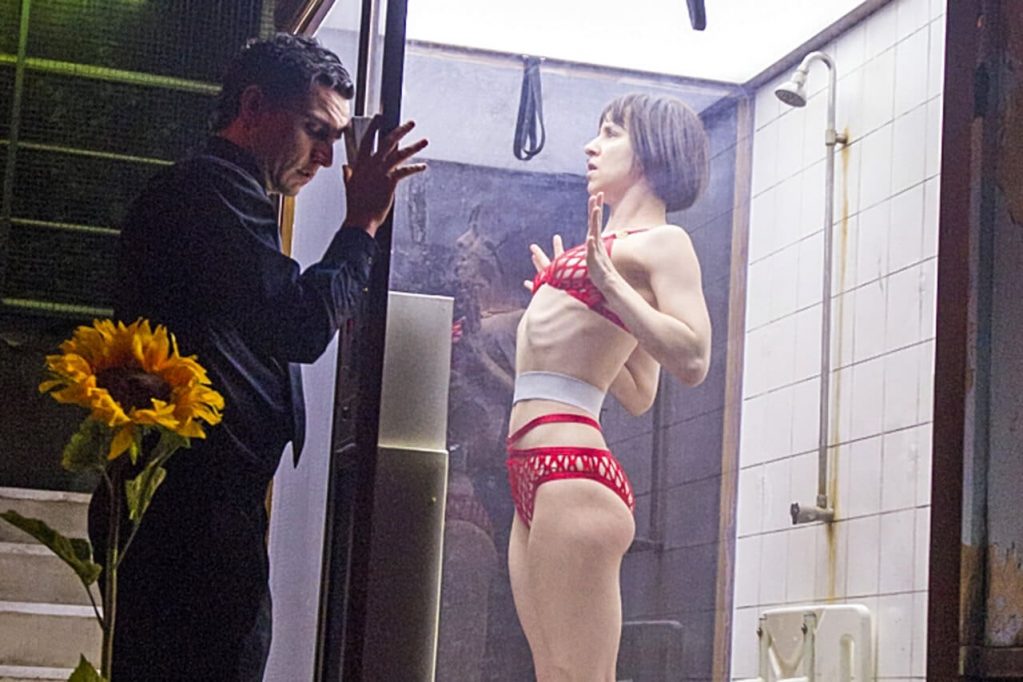Love struggles in this scarred place, but there are moments which slay us with tenderness.
I could, as some have done by way of a critique, reel off a list. The list would recount acts of torture. It would go on a bit, but not with the intention of impressing upon the reader that torture is indeed vile and brutal, relentless and cruel, but to let the reader know just how singularly perverse this world the writer has created is. And I’d only mention the litany of vile acts in order to underscore how nausea-inducing, numbing, or, in fact, dull and flat this play is (an accusation of dullness often being the unexamined response to any piece of art that makes the affronted viewer feel profoundly uncomfortable – “dull”, since no one wants to sound like the proverbial maiden aunt). Why else give an ad nauseum list – “and this horror, and that horror, and this” – but to eviscerate Sarah Kane’s Cleansed of all its metaphoric weight and poetry?
I went to see Cleansed earlier this week and this is the thing: I have rarely felt so tensely alert in the theatre, so acutely alive to meaning and nuance and symbolism and texture. And I have rarely been so affected by an exploration of grief which struck me as profoundly truthful, nor by the raw hunger for love’s redemption – an exploration of a hunger as far removed from B-rated sentiment as one can get. I left the theatre wondering how one could be left unmoved by all that – and that this was a play, so rich and dense in its concision, very much “about love”, as Kane herself described it.
But I wasn’t expecting any of that. Having read about Kane over the years, both before her death, in 1999, and since, including the recent batch of reviews for Cleansed (the atrocity list repeated ad nauseum), I was, I suppose, expecting to be bludgeoned senseless. And since Cleansed is, very oddly, the first Kane production staged by the National Theatre, it’s not surprising I was steeling myself for the mindless assault, since this was my first production of her work, too. And at the back of my mind was the thought that Kane might have dated badly – a case of 90s sensationalism. (The whole brute noise and viscera thing – you know, very 90s.) And so it was that I went to see the play out of a dutiful sense of curiosity.
But it hasn’t dated, and I wasn’t bludgeoned. And Katie Mitchell’s production is extraordinary. I don’t know how explicit Kane’s published stage directions are, but one can be certain that Mitchell gets right under the skin of the text and serves Kane beautifully. She roots the action in a setting resonant with familiarity – a municipal building which looks like a dilapidated school or hospital. And for this battle-scarred setting (at one point we hear rockets or rapid gunfire located outside) she creates a soundscape that’s inescapably insistent and present: the constant woozy pulsing-in-the-bloodstream sound that makes me think of Eliot’s “Wire in the blood” and his “dance along the artery/The circulation of the lymph”. We are, after all, in the land of “inveterate scars” – battle scars, and spiritual ones that don’t heal.
Then there’s the awful institutional buzzer that’s pressed whenever another atrocity is about to be enacted and which hurries the action along at a relentless pace – a nod, naturally, to 20th-century evils perpetrated with bureaucratic efficiency and of a piece with doctor figure Tinker’s refrain, “I am not responsible.” And beyond this, the energetic bursts of pulsing music, coupled with the frenetic dancing of two of its inmate characters – a momentary joy in forgetfulness. We are witnesses to agony and ecstasy (and it doesn’t come as a surprise to learn that Kane was a born-again Christian as a teenager). And what of the cruelly jarring tenderness – almost blackly comic in its timing – of Blondie’s Picture This sung by a child? Love struggles in this scarred place, but there are moments which slay us with tenderness. And just as in Orwell’s 1984, in which we can find echoes and allusions here, evil looks for the soft spots in order to thrive. It wants us to embrace it; it seeks our willing, even orgiastic surrender.
I won’t go on about other aspects of Mitchell’s taut and beautifully choreographed direction. I’ll just end with another thing I found extraordinary. For all her concern with symbolism and metaphor, Kane had a truly rare and remarkable ear for naturalistic dialogue. Amid the horror are exquisite moments of recognition located in speech. Not since Pinter (an early champion of Kane’s work) or, outside theatre, Don Delillo, have I come across anything quite like it. It’s a rare gift – and Kane really was the real deal.
